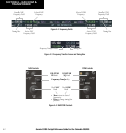
Garmin G1000 Cockpit Reference Guide for the Columbia 350/400
4-3
SECTION 4 – NAV/COM &
TRANSPONDER
4.1 RADIO STATUS INDICATIONS
• RX – When a COM signal is received, a white ‘RX’
appears by the active COM frequency during signal
reception.
• TX – When a COM radio is transmitting, a white ‘TX’
indication appears to the right of the corresponding
COM frequency.
• ID – When the Morse code identifier is ON for a NAV
radio, a
white ‘ID’ indication appears to the left of
the corresponding active NAV frequency. The Morse
code identifier can be heard if the corresponding
NAV radio is selected on the audio panel.
Figure 4-5 Radio Status Indications
4.2 VOLUME
‘VOLUME’ is displayed in place of the associated radio
name (i.e., ‘COM1’ or ‘NAV2’) for two seconds after the
volume level is last changed. The percentage of maximum
volume is displayed in place of the standby frequency
selected by the tuning box.
Figure 4-6 COM Volume Level
4.3 AUTOMATIC SQUELCH
Automatic squelch can be disabled for a COM radio by
pressing the COM Knob to place the tuning box on the
desired COM’s standby frequency, then by pressing the
VOL/PUSH SQ Knob.
4.4 QUICKLY ACTIVATING 121.500 MHZ
Pressing and holding the COM Frequency Transfer
Key for approximately two (2) seconds automatically tunes
the selected COM radio to the emergency frequency.
4.5 FREQUENCY AUTO-TUNING
Auto-tuning on the PFD
Figure 4-7 Nearest Airports Window (PFD)
1) Select the
NRST
Softkey to display the Nearest
Airports Window.
2) Turn either
FMS
Knob to highlight the desired
frequency.
3) Press the
ENT
Key to place the frequency in the
standby field of the active COM.
4) Press the
Frequency Transfer
Key to place the
frequency in the active field.
NAV frequencies are entered automatically in the active
NAV frequency field upon approach loading or approach
activation.
Auto-tuning on the MFD
Auto-tuning on the MFD is done in much the same way
as on the PFD. Use the FMS Knobs to select the desired
frequency on any of the information pages. Pressing the
ENT Key then loads the selected frequency in the tuning
box as a standby frequency.


















